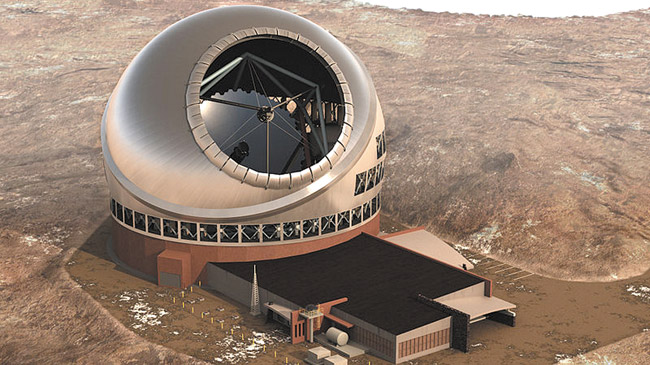Is New Mauna Kea ’Scope Worth It?
In 1609, it was the biggest telescope on the planet.
Galileo’s 1.5-centimeter instrument in Italy set the science world and the Catholic Church on fire.
This year, the academic fire is about the planned 30-meter telescope (TMT) for Mauna Kea on Hawaii island, a 39-meter European Extremely Large Telescope (E-ELT) at Cerro Amazones, Chile, and a 24-meter Giant Magellan Telescope (GMT) at Las Campanas, Chile.
It’s a $3.3-billion race with no assurance that our Mauna Kea project can win it, that the $1.2 billion for ours will draw enough astronomers to use it, or that it will have been worth all that fighting over its environmental impact atop the water-bearing and sacred-to-some mountain.
I’ve come to that conclusion after scouring all the publicly available information on the three scopes. Some of the project’s promoters can be expected to disagree. Each believes in his baby.
I’ve not been opposed to the TMT project. Mauna Kea’s summit already is full of scopes, and I fail to see how one more is a desecration. But what if the Chile scopes make ours redundant?
We need assurance the project will get fully funded, and if enough space-gazers will pay to use it now that the Gemini North (Mauna Kea) and Gemini South (Chile) experimental scopes seem to say Chile is the far better sky-watching site.
GMT in Chile is expected to be up by 2020; ours by 2022, if we keep on track with no further court action. Of course, by then we could have orbiting telescopes that make most all the ground ones obsolete. (Ground and space astronomers tend to disagree on that.)
Financing: The European ELT has participating countries pledging a percentage of their gross domestic product toward it. Our Mauna Kea TMT uses corporate and foundation funding, and the GMT Chile uses mainly private investment. China is building the mirror as a contribution to the Mauna Kea project. GMT rejected in-kind national contractors, and awards work solely based on scientific merit.
The Chile project didn’t run into the kind of environmental and cultural objections ours has, so it’s expected to be up way ahead of ours and siphoning off astronomers’ booking time.
The worst outcome I can imagine would be for us to build the 18-stories-tall (184 feet) shell for the TMT and then run out of money or interest. We’d have a visual monstrosity up there for no reason.
But as I said earlier, some of the Mauna Kea project overseers may have a different outlook. They are: Association of Canadian Universities, Caltech, University of California, Department of Science and Technology of India, Chinese Academy of Sciences and National Astronomical Observatory of Japan.
I suggest we make sure the money’s there, and the astronomer interest, too, before we give out that final, no-can-revoke building permit.
BanyanTreeHouse@gmail.com







